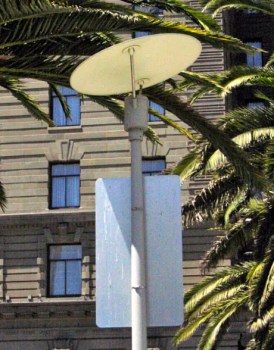Street lighting is a key organizing streetscape element that defines the nighttime visual environment in urban settings. Street lighting includes roadway and pedestrian lighting in the public right-of-way. Street light poles and fixtures can also create a defining visual characteristic during daylight hours.
Quality street lighting helps define a positive urban character and supports nighttime activities. The quality of visual information is critical for both traffic safety and pedestrian safety and security. Lighting should be designed not only for vehicular traffic on the roadways, but also for pedestrians on sidewalks and pedestrian paths.
Process Overview
Most street lighting in San Francisco is owned and managed by either the San Francisco Public Utilities Commission (SFPUC) or PG&E.
The SFPUC is currently developing a catalog of street lights for San Francisco. Through this effort, the SFPUC will also create an official process for street light approvals.
Contact the SFPUC Power Enterprise Utility Services Group for more information
Street lights that are not within SFPUC’s catalog must apply and receive a variance from the SFPUC Commission to install a non-catalog fixture.
If your project involves multiple streetscape elements, you must obtain relevant permits for all features. For projects involving various streetscape elements, DPW will often streamline the process by combining multiple elements under one or more permits.
See Permit Process for more information.
Official Codes & Documents
- Better Streets Plan (street design guidelines)
- Street Light Catalog – Coming soon!
- Guide to San Francisco Street Lights – Coming soon!
Design Guidelines
The SFPUC is in the process of defining an approved catalog of street light fixtures for San Francisco – check back soon for more information!
Location
Street types: All
Sidewalk zones: Furnishings Zone; Edge Zone
Location and Spacing
Street lighting poles should be located on the sidewalk close to the curb on the curb side edge, or centered within, the furnishing zone. Typically, pedestrian lighting poles align with the street lighting poles. However, on very wide sidewalks pedestrian lighting poles may be farther from the curb than the street lighting poles to light the primary walkway.
Light poles should be coordinated with other streetscape elements. Utility equipment above and below ground, such as pull boxes and underground trenches, should be coordinated when locating lighting fixtures.
Light fixtures should not be located next to tree canopies that may block the light. When determining tree type, anticipated height and diameter of the tree canopy should be considered relative to lighting fixture height and spacing based on light level and uniformity requirements. Appropriate distance between the tree and light fixture depends upon the type of tree and type of light fixture. If blocking the light output of the fixture cannot be avoided due to existing locations of the light fixture and trees, consider adding additional light fixtures to mitigate the shadows from the tree canopy.
The rhythm of the light poles should be consistent in a given neighborhood. On wide streets, light fixtures should be located on both sides of the street, and can be staggered or directly opposite depending upon light level and uniformity considerations. Light poles should have a consistent spacing with regard to trees and other street poles.
Light Distribution
Light fixtures should be selected to efficiently direct light to the desired area of the roadway and sidewalk. Light fixtures should enable a variety of light distributions to adapt to different street and sidewalk configurations while maintaining the same fixture appearance. The distribution type should be selected based on street and sidewalk width.
Glare should be mitigated by selecting the proper optical design. Sky glow is a consequence of several components of lighting: light directed to the sky from fixtures and light reflected off the ground. Light trespass is light that enters an area where it is not wanted, such as street light entering a residential property. Both sky glow and light trespass can be irritating and detrimental to the environment.
Sky glow should be mitigated by selecting dark sky friendly lighting fixtures that direct most of the light downward, by eliminating excessive light level, and turning lights off when not needed. New and replacement light fixtures should achieve a semi-cutoff light (5% or less concentration of light above a 90 degree angle from the fixture than the light output of the fixture). Luminaire cut-off classifications do not apply to LED fixtures.


Downward-facing lighting prevents excess light from trespassing into adjacent buildings.
Light trespass should be mitigated by specifying the correct light distribution. Lighting fixtures should not be located close to windows to avoid light trespass or glare and disturb the adjacent building’s occupants. If necessary, house-side shields may be used on fixtures to minimize light trespass into residences or other areas.
Light Levels and Uniformity
Roadway Lighting
Lighting fixture spacing should be based on light level and uniformity requirements in the American National Standard Practice for Roadway Lighting (RP-8) by the IESNA, the adopted city lighting standard, shown in Lighting Table 1. Roadway classifications used in RP-8 are based on traffic volume. Light levels will decrease as lamps get old and lighting fixtures get dirty. Light levels should be adequate even when light levels decrease over time. Light level calculations should be performed using the light loss factor stipulated by the City to account for these anticipated decreases.
Lighting Table 1: Roadway Light Levels
*Numbers indicate broad range – consult RP-8 for greater specificity.
| STREETSCAPE TYPE | Horizontal light level range1,2 at ground Minimum maintained average3 | Uniformity ratio range1,2 Average/Minimum |
|---|---|---|
| Downtown Commercial | Defer to Downtown Streetscape Plan | Defer to Downtown Streetscape Plan |
| Downtown Residential, Neighborhood Commercial (IESNA Roadway classifications: Major/Collector/Local) | 0.4 to 1.7 | 3 to 6 |
| Commercial Throughway (IESNA Roadway classifications: Major/Collector) | 0.6 to 1.7 | 3 to 4 |
| Neighborhood Residential (IESNA Roadway classifications: Collector/Local) | 0.4 to 1.2 | 4 to 6 |
| Residential Throughway (IESNA Roadway classifications: Major/Collector/Expressway) | 0.6 to 1.7 | 3 to 4 |
| Industrial Multi-way Boulevard4 (IESNA Roadway classifications: Major/Collector/Local/Expressway) | 0.4 to 1.7 | 3 to 6 |
| Mixed-Use Parkway Park Edge (IESNA Roadway classifications: Major/Collector/Local) | 0.4 to 1.7 | 3 to 6 |
| Ceremonial (Civic) | Defer to potential subsequent design plan | Defer to potential subsequent design plan |
| Paseos (IESNA classification: Pedestrian walkway) | 0.4 to 1 | 4 to 6 |
1. Requirements in RP-8 are periodically revised and updated. Latest edition should be used for determining the light level and uniformity ratio requirements.
2. A range of light levels are listed. The exact minimum maintained average light level depends upon traffic and pedestrian volume and pavement classification (related to pavement reflection of light) for any given street. These variables must be verified for each street to determine exact minimum maintained average value. Verify technical classifications with the City for both roadway and pedestrian paths for individual streets.
3. Minimum maintained average is the lowest accepted value of an average light level calculated with a light loss factor.
4. A Multi-way Boulevard may have different roadway classifications for the throughway portion and the local access lanes of the boulevard. Local access lane lighting requirements will vary with adjacent land use context. Verify technical classification with the City for each street.
Intersection Lighting
Crosswalks should follow Illuminating Engineering Society of North America (IESNA) intersection guidance to illuminate pedestrians in the crosswalk to vehicles (Lighting Table 2). Crosswalk lighting should provide color contrast from standard roadway lighting.
Lighting Table 2: Intersection/Crosswalk Light Levels
| Functional Classification | Average Maintained Illumination at Pavement by Pedestrian Area Classification (LUX/FC) | ||
|---|---|---|---|
| HIGH | MEDIUM | LOW | |
| Major/Major | 3.4 fc | 2.6 fc | 1.8 fc |
| Major/Collector | 2.9 fc | 2.2 fc | 1.5 fc |
| Major/Local | 2.6 fc | 2.0 fc | 1.3 fc |
| Collector/Collector | 2.4 fc | 1.8 fc | 1.2 fc |
| Collector/Local | 2.1 fc | 1.6 fc | 1.0 fc |
| Local/Local | 1.8 fc | 1.4 fc | 0.8 fc |
Light levels are measured in foot candles (fc) which refers to the distance (in feet) that is illuminated away from the source of light, measured in lumens per square foot. Functional Classification of street types is based on IESNA standards.
Refer to the latest edition of Recommended Practices for Roadway Lighting, RP-8-00, of the IESNA.
Pedestrian Lighting
Pedestrian lights are lights in the right-of-way that primarily function to illuminate pedestrian areas such as sidewalks. The SFPUC defines pedestrian lights as pole-mounted lighting fixtures less than 18 feet tall that are part of a secondary lighting system used to supplement street lighting levels.
The City currently does not have standards for pedestrian light levels. Preliminary targets for pedestrian light levels for each Better Streets Plan type are shown in Lighting Table 3. These levels refer to light directed on pedestrian zones such as sidewalks, shared public ways, public stairways, and other pedestrian paths. Light levels are measured in foot candles (fc), which are approximately the distance (in feet) that is illuminated away from the source of light, measured in lumens per foot.
Pedestrian lighting should be provided on high pedestrian volume corridors or where a special design treatment is desired to supplement roadway lighting. Pedestrian lighting should be consistent throughout a block and minimize variance between bright and dark areas.
In general, providing sidewalks with a minimum luminance of 0.5 fc allows pedestrians to detect obstacles, stay visually oriented, and recognize faces from a distance of 13 feet, a minimum distance that brings comfort with regard to normal social contact. For high crime or activity areas, higher values may be considered.
Pedestrian lighting should be prioritized in the following locations:
- Streets with high pedestrian volumes
- Key civic, downtown, and commercial streets
- Streets with concerns about pedestrian safety and security, such as at freeway underpasses
- Small streets such as alleys and pedestrian pathways
Lighting Table 3: Pedestrian Lighting Levels
| Streetscape Type | Light Level |
|---|---|
| Commercial | 1 fc |
| Mixed-Use | 0.5 fc |
| Residential | 0.3 – 0.4 fc |
| Industrial | 0.3 fc |
| Alleys and Paseos | 0.3 fc |
| Special | Varies |
Light levels are measured in foot candles (fc) which refers to the distance (in feet) that is illuminated away from the source of light, measured in lumens per square foot. Suggested light levels are consistent with ANSI/IES RP-8-00 American National Standard Practice for Roadway Lighting.
Maintenance
Maintenance Responsibility
Street lights in San Francisco are generally owned and maintained by utility providers, including the SFPUC and PG&E. SFPUC will maintain street lights that are within their approved catalog, which is currently being revised. Some street lights are maintained by other agencies, including SFMTA, DPW, and the Recreation and Parks Department.
The SFPUC is in the process of updating the catalog of approved street lights, and developing a process for approval of new street lights.
To report a street light issue, call or go to 311.
For a more detailed description of maintenance responsibilities, see Maintenance.
Maintenance Practices
Tree pruning is important to maintain uniform light levels on the street. The clearance between tree foliage and the lighting fixture is dependent upon the tree type and lighting fixture type and height.
See Greening Overview, Street Trees and Median Greening for more information.









 Copyright © 2015
Copyright © 2015